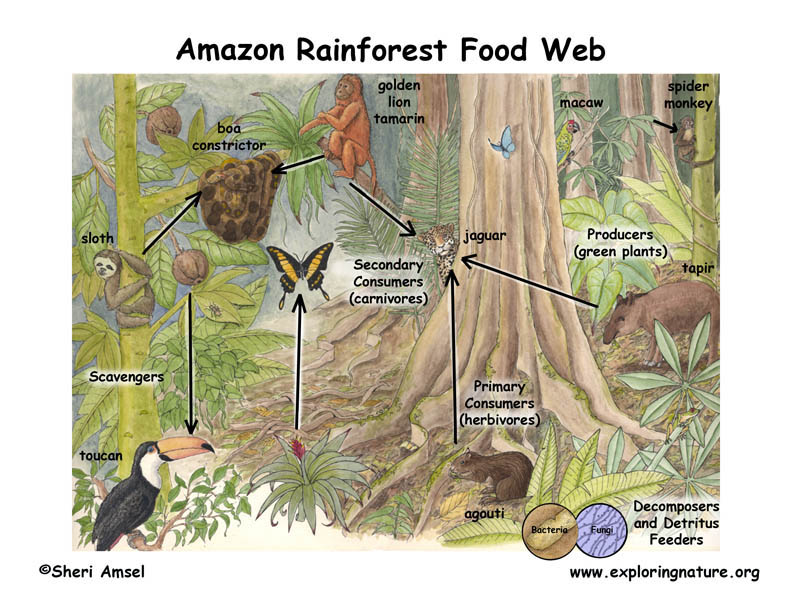Tropical rainforest meals webs, intricate networks of life, function vibrant and dynamic ecosystems that help an astonishing array of species. Delve into this fascinating world the place producers, customers, and decomposers have interaction in a harmonious dance, guaranteeing the fragile steadiness of nature.
Inside the lush embrace of tropical rainforests, a symphony of life unfolds, with crops, animals, and microorganisms enjoying important roles within the intricate meals net. This dynamic ecosystem is a testomony to the interconnectedness of all residing issues, showcasing the exceptional resilience and adaptableness of nature.
Introduction to Tropical Rainforest Meals Webs

Tropical rainforests, characterised by their heat, humid climates and plentiful rainfall, are among the many most numerous ecosystems on Earth. These lush forests harbor a staggering array of plant and animal species, forming intricate meals webs that help the ecological steadiness of those important habitats.
Meals webs are complicated networks that illustrate the feeding relationships amongst species inside an ecosystem. They supply insights into how vitality and vitamins stream by means of the system, connecting producers (organisms that create their very own meals by means of photosynthesis or chemosynthesis) to customers (organisms that get hold of vitality by consuming different organisms).
Distinctive Options of Tropical Rainforest Meals Webs
Tropical rainforest meals webs exhibit distinctive traits that distinguish them from different ecosystems:
- Excessive Species Range:Tropical rainforests help an astonishing array of plant and animal species, leading to complicated meals webs with quite a few trophic ranges and interactions.
- Vertical Stratification:The luxurious vegetation in tropical rainforests creates distinct vertical layers, from the forest ground to the cover, every supporting a singular assemblage of species and feeding relationships.
- Ample Decomposers:Tropical rainforests have a excessive abundance of decomposers, comparable to fungi and micro organism, which play a vital position in breaking down useless natural matter and recycling vitamins again into the ecosystem.
Producers in Tropical Rainforest Meals Webs

The luxurious tapestry of life in tropical rainforests owes its vibrant hues to a symphony of producers, primarily crops, that seize daylight and remodel it into energy-rich compounds. These botanical wonders have developed exceptional diversifications to thrive within the distinctive situations of the rainforest, guaranteeing a steady stream of vitality that sustains the whole meals net.
Diversifications of Rainforest Crops
- Broad, Skinny Leaves:To maximise daylight absorption, many rainforest crops possess broad, skinny leaves that unfurl like photo voltaic panels in the direction of the cover.
- Drip Suggestions:The incessant rainfall in rainforests can overwhelm leaves, probably blocking daylight. To counter this, many crops have developed drip ideas that facilitate water runoff.
- Buttress Roots:The shallow, nutrient-poor soils of rainforests usually necessitate intensive root methods. Buttress roots, which resemble thick, vertical helps, present stability and entry to vitamins.
- Epiphytes:Some rainforest crops, referred to as epiphytes, cling to the branches and trunks of timber, utilizing them as platforms to achieve daylight with out competing for vitamins within the soil.
Function within the Meals Internet
As the inspiration of the rainforest meals net, producers harness daylight by means of photosynthesis and convert it into carbohydrates. These carbohydrates function the first vitality supply for all organisms within the ecosystem. Herbivores eat producers instantly, whereas carnivores and omnivores not directly get hold of vitality from producers by feeding on herbivores.
The abundance and variety of producers in tropical rainforests help a fancy net of interactions, guaranteeing a steady stream of vitality and sustaining the intricate steadiness of life on this verdant realm.
Shoppers in Tropical Rainforest Meals Webs

Shoppers in tropical rainforests play important roles in sustaining the ecosystem’s steadiness. They feed on producers and different customers, changing vitality from one degree to the following. Let’s discover the completely different ranges of customers and their interactions throughout the meals net.
Herbivores
Herbivores are main customers that feed completely on plant matter. They eat leaves, fruits, seeds, and different plant supplies, changing plant vitality into animal vitality. Examples of herbivores in tropical rainforests embrace monkeys, deer, tapirs, and sloths.
Carnivores
Carnivores are secondary or tertiary customers that feed on different animals. They eat meat, both by searching or scavenging. Examples of carnivores in tropical rainforests embrace tigers, leopards, jaguars, and eagles.
Omnivores
Omnivores are customers that feed on each crops and animals. They’ve a extra numerous food regimen than herbivores or carnivores. Examples of omnivores in tropical rainforests embrace bears, raccoons, and a few species of monkeys.
Shoppers work together with one another and with producers throughout the meals net by means of feeding relationships. Herbivores eat crops, that are produced by autotrophs. Carnivores eat herbivores or different carnivores, and omnivores eat each crops and animals. These interactions create a fancy community of vitality stream throughout the rainforest ecosystem.
Decomposers in Tropical Rainforest Meals Webs
Decomposers play a significant position within the tropical rainforest ecosystem by breaking down natural matter and recycling vitamins again into the atmosphere. With out decomposers, useless crops and animals would accumulate, and the rainforest would finally develop into devoid of vitamins.
Function of Decomposers
Decomposers are organisms, primarily fungi and micro organism, that break down useless crops and animals, in addition to different natural matter, into less complicated substances. These less complicated substances are then launched again into the soil, the place they can be utilized by crops as vitamins.
Significance of Decomposers
Decomposers are important for sustaining the steadiness of the tropical rainforest meals net. With out decomposers, vitamins can be locked up in useless natural matter and unavailable to crops. This may result in a decline in plant development and finally a decline in the whole meals net.
Vitality Circulation and Nutrient Biking in Tropical Rainforest Meals Webs
Vitality stream and nutrient biking are basic processes that maintain tropical rainforest meals webs. Vitality flows by means of completely different trophic ranges, from producers to customers to decomposers, whereas vitamins are recycled again into the ecosystem to help plant development and vitality manufacturing.
Vitality Circulation in Tropical Rainforest Meals Webs
Vitality enters the tropical rainforest meals net by means of photosynthesis, the place crops use daylight to transform carbon dioxide and water into glucose. This glucose serves as the first vitality supply for all different organisms within the ecosystem.
Vitality flows by means of completely different trophic ranges as organisms eat one another. Producers, comparable to crops and algae, are on the first trophic degree. Main customers, comparable to herbivores, feed on producers and are on the second trophic degree. Secondary customers, comparable to carnivores, feed on main customers and are on the third trophic degree.
This sample continues with higher-level customers, comparable to apex predators, on the high of the meals net.
At every trophic degree, a good portion of vitality is misplaced as warmth because of metabolic processes. Because of this the quantity of vitality obtainable to organisms at greater trophic ranges is decreased in comparison with these at decrease ranges. In consequence, there’s a restrict to the variety of trophic ranges that may be supported in a meals net.
Nutrient Biking in Tropical Rainforest Meals Webs
Nutrient biking is the method by which vitamins are taken up by organisms, used for development and upkeep, after which launched again into the atmosphere. In tropical rainforests, vitamins are primarily saved within the biomass of residing organisms and within the soil.
Vitamins are launched again into the soil by means of decomposition, which is the method by which useless organisms are damaged down by microorganisms. These microorganisms convert natural matter into inorganic vitamins that may be taken up by crops. Crops then use these vitamins to supply new biomass, which is finally consumed by different organisms, persevering with the nutrient cycle.
Abiotic components, comparable to temperature and rainfall, can affect vitality stream and nutrient biking in tropical rainforest meals webs. Temperature impacts the metabolic charges of organisms, which in flip impacts the speed of vitality stream by means of the meals net. Rainfall impacts the provision of water and vitamins, which may impression plant development and the general productiveness of the ecosystem.
Disturbances and Resilience in Tropical Rainforest Meals Webs
Tropical rainforest meals webs are dynamic methods which might be continuously formed by disturbances. These disturbances could be pure, comparable to hurricanes, droughts, and fires, or they are often attributable to human actions, comparable to deforestation, logging, and mining.
Meals webs reply to disturbances in a wide range of methods. Some species could also be eradicated from the online, whereas others could improve in abundance. The general construction of the online may change, as new connections are shaped and previous ones are misplaced.
Mechanisms of Resilience
Regardless of the challenges posed by disturbances, tropical rainforest meals webs have developed numerous mechanisms that promote resilience. These mechanisms embrace:
- Range:Tropical rainforests are dwelling to an extremely numerous array of species. This range gives a buffer towards disturbances, as there are all the time different species that may fill the roles of these which might be misplaced.
- Redundancy:Many species in tropical rainforests have a number of prey or predator species. This redundancy helps to make sure that the online stays intact even when a number of species is misplaced.
- Practical redundancy:Many species in tropical rainforests carry out related capabilities. This useful redundancy helps to make sure that the online can proceed to perform even when a number of species is misplaced.
Significance of Biodiversity
The upkeep of biodiversity is crucial for the steadiness and resilience of tropical rainforest meals webs. The extra numerous an internet is, the extra seemingly it’s to have the ability to stand up to disturbances and preserve its general construction and performance.
The lack of biodiversity can have a devastating impression on tropical rainforest meals webs. For instance, the lack of a single species of predator can result in a rise within the abundance of its prey, which may in flip result in a lower within the abundance of the prey’s meals supply.
This could create a ripple impact that may destabilize the whole net.
FAQ
What are the important thing traits of tropical rainforests?
Tropical rainforests are characterised by their heat, humid local weather, plentiful rainfall, and luxurious vegetation, supporting a various array of plant and animal life.
How do producers contribute to tropical rainforest meals webs?
Producers, primarily crops, convert daylight into vitality by means of photosynthesis, offering the inspiration for the meals net and supporting all different organisms.
What position do decomposers play in tropical rainforest meals webs?
Decomposers, comparable to fungi and micro organism, break down natural matter, releasing vitamins again into the ecosystem and guaranteeing the biking of important parts.




